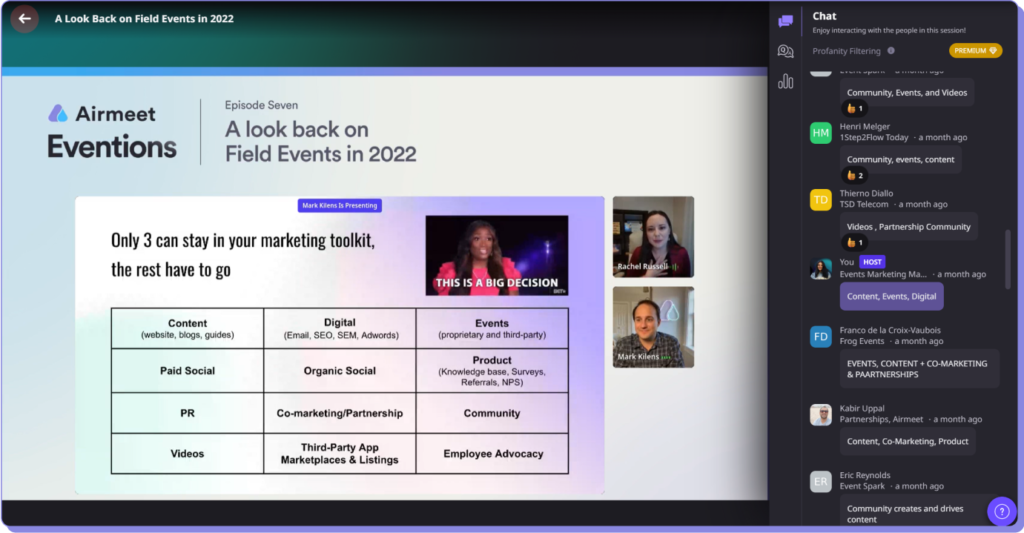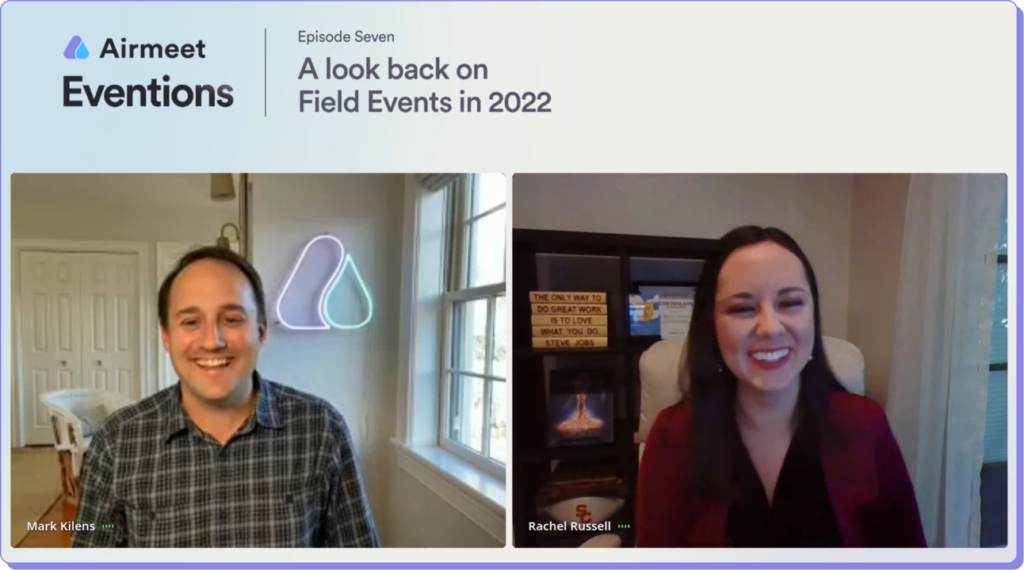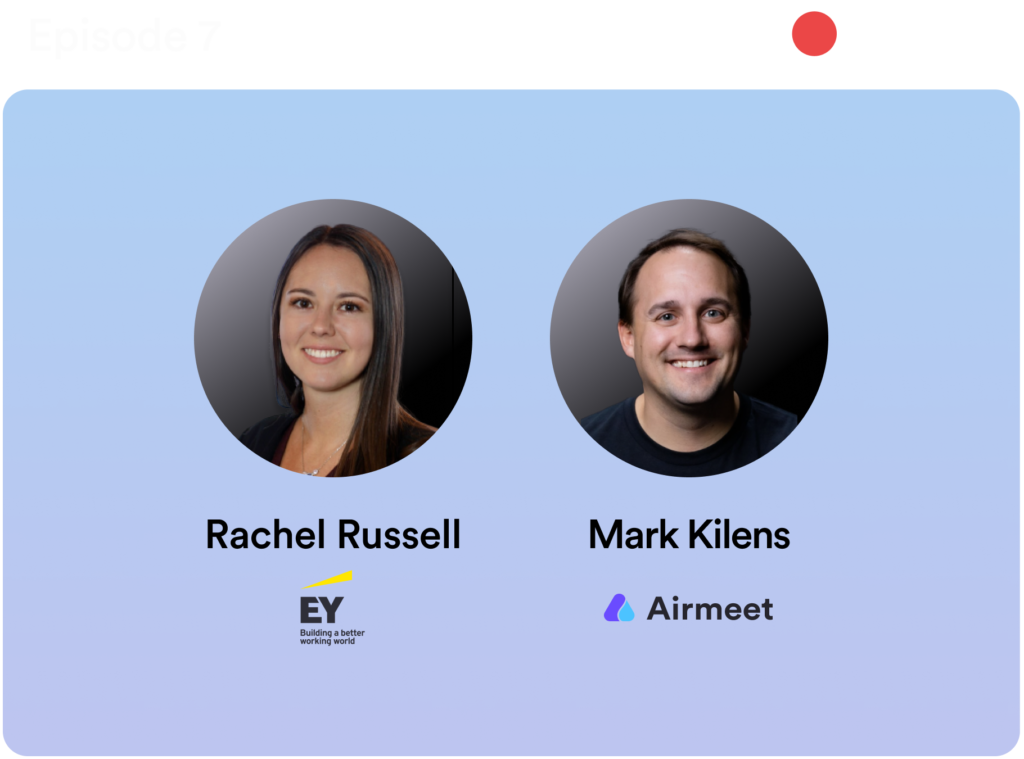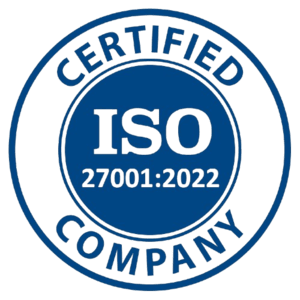In 2022, we returned to field marketing. But the excitement of getting back together in person was quickly overshadowed by the global economic downturn.
Now, as we peer into 2023, we’re wondering what’s in store for field events, budgets, and attendee expectations.
Airmeet’s CMO Mark Kilens chatted with Rachel Russell, Assistant Director of Field Marketing at EY, a large consulting and accounting firm.
During our recent live Eventions episode: A Look Back on Field Events in 2022, Mark and Rachel dissected what worked and what didn’t. They also covered how field marketers can stand out and drive more leads in 2023, no matter their budget.
2022 was the year the world returned to live, in-person events and tradeshows. But amidst all this, the economy continued to slow throughout the year. Layoffs and budget cuts were prevalent, causing many companies to rethink their approach to costly live events.
Attendee Franco de la Croix-Vaubois joined the chat to share his view of the recent changes. He predicts that virtual events will grow in 2023 to meet the demands of reduced marketing budgets. Virtual events provide a fantastic opportunity to keep the line of communication open with customers at a reduced cost.
We asked our audience if they had to choose only 3 channels or tactics to keep in their marketing toolkit, what would they pick? Rachel chose content, events, and product as her top 3 because, for her, these are absolute essentials for successful marketing.

Tons of attendees choose events as well. The amount of connection they provide is unmatched.
How to choose the perfect event mix (owned versus sponsored)
How many events should you host? How many should you sponsor?
Rachel says that the right mix of owned VS sponsored events comes down not only to the scale and size of the company, but their brand recognition too.
Her experience spans a variety of companies and industries:
- At Deloitte, the mix was 50% third-party trade shows and 50% proprietary events to take advantage of both opportunities.
- At startup ONE, the mix was 100% on third-party trade shows due to a lack of brand recognition and a need to get their name out there.
- At EY (where Rachel currently works), the approach is 20% third-party event sponsorships to access new audiences and 80% proprietary events to curate special experiences for clients and prospects.
For smaller companies, Rachel encourages hosting small roadshows throughout the year versus hosting one large conference because you’ll reach more of your audience. People won’t have to travel so far to attend the event, and once they show up, they’ll be treated to a more intimate experience.

Pro tips for exhibiting at a trade show
If you want your field marketing activation to be successful, you need to put in the work before the event happens. For instance, you might create a dedicated website to share details about your presence at the event, including Calendly links where attendees can book 1:1 meetings.
You also need to create a differentiator that will encourage attendees to visit your booth, out of the dozens or hundreds available.
At Deloitte, instead of having a traditional booth, we had a lounge area with branded phone bank chargers that were secure and could only be opened with your pin so you didn’t have to worry about your phone getting taken. We had a ton of traffic that way, and were able to drive a lot of conversation.
Rachel Russell, Assistant Director of Field Marketing at EY Tweet
Whether it’s a fun experience or a menu of free branded cocktails, you need to think creatively if you want to stand out.
Mark and Rachel both agree that if you’re just going to host a booth with basic collateral, you’re better off ditching the booth idea altogether and participating in networking sessions instead. Or, you might try hosting your own micro-networking event nearby.
How field marketing strategy has changed since the pandemic
Rachel has noticed that marketers have focused more on quality over quantity when it comes to measuring event success.
Before, there was a huge focus on the number of interactions, like how many people showed up to the dinner you hosted. Now, I feel like that has switched to focus more on quality. If you have fewer people show up, but there are really great conversations that actually lead to sales leads, that’s awesome. People are a lot more aware of that now.
Rachel Russell, Assistant Director of Field Marketing at EY Tweet
In Rachel’s corporate experience, there had previously been a lot of pushback from enterprise partners with anything virtual. But post-pandemic, Rachel has been able to organize a lot of creative virtual events more easily. She hosted a Power of Women event with Facebook and Deloitte, including a female beatboxing champ who improvised a song based on what attendees were dropping in the chat.
Expensive VS. inexpensive field event activations
There are a lot of competing options for attendees' free time. They have a lot of people inviting them to drinks and free dinner so just hosting a reception isn’t enough to guarantee attendance. You need to really think through what is my draw?
Rachel Russell, Assistant Director of Field Marketing at EY Tweet
With so much competing attention, you need to offer something special. Rachel has certainly hosted high-budget events (we’re talking invite-only events with free custom Nikes for every attendee and private concerts with the Black Eyed Peas).
But special experiences don’t always have to cost that much. You might raffle away one big prize instead of spending a lot of money on each person. Or, you might host a dinner with a chef and give each attendee a signed copy of their book.
No matter your budget, make sure you put as much effort as possible into spreading the word before the event. For instance, if you’re raffling away Super Bowl tickets, use a variety of marketing channels to let people know to stop by your booth and enter that raffle.
Planning and budgeting your field events for 2023
How do you plan for field budgets when budget cuts and uncertainty are afoot?
While we can’t predict the future, we can offer Rachel’s best tips:
- Research and identify the top conferences in your field or location ASAP.
- Start conversations with conferences early on so you’re more likely to get the first choice as the top booth locations become available.
- Know that sponsorships are always negotiable and you can piece together elements from different sponsorship levels and ask for a custom price.
- Don’t just pay for the sponsorship and call it good. Bring your unique creativity and branding to offer special gifts, experiences, and opportunities.
- Review your budget early and often, so there are no surprises. Have multiple options for special experiences so you can adjust to budget cuts.
- Know that there are 3 main factors that ultimately go into your perfect event mix strategy: budget, brand recognition, and team capacity. Above all else, think creatively so you can maximize your budget and every interaction.




























